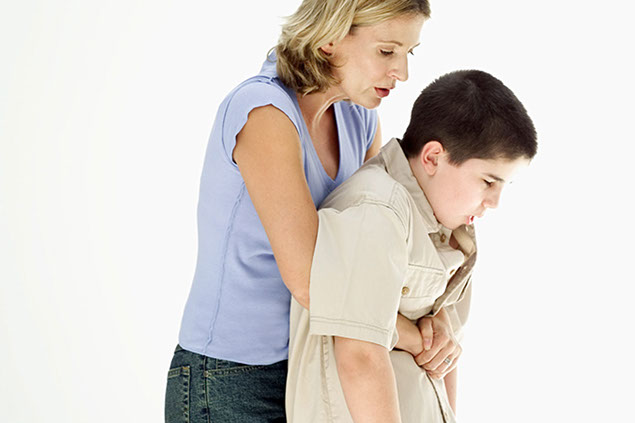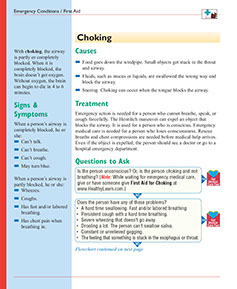CONDITIONS
SYMPTOM CHECKER
Male
Female
Child
Arm, Hand & Shoulder Concerns
Legs & Feet Concerns
Dental & Mouth Concerns
Ear & Nose
Eye Conditions
Head Conditions
Arm, Hand & Shoulder Concerns
Legs & Feet Concerns
Front
Back
Arm, Hand & Shoulder Concerns
Dental & Mouth Concerns
Ear & Nose
Eye Conditions
Head Conditions
Arm, Hand & Shoulder Concerns
Dental & Mouth Concerns
Ear & Nose
Eye Conditions
Head Conditions
Front
Back
Arm, Hand & Shoulder Concerns
Neck Links
Head & Neck Concerns
Arm, Hand & Shoulder Concerns
Neck Links
Head & Neck Concerns
Front
Back
Online Clinic
Wise Healthcare
Choking
With choking, the airway is partly or completely blocked. When it is completely blocked, the brain doesn’t get oxygen. Without oxygen, the brain can begin to die in 4 to 6 minutes.
First Aid for Choking
Signs & Symptoms
When a person’s airway is completely blocked, he or she:
Learn CPR. It Could Save a Life!
• Can’t talk.
• Can’t breathe.
• Can’t cough.
• May turn blue.
When a person’s airway is partly blocked, he or she:
Causes
• Food goes down the windpipe. Small objects get stuck in the throat and airway.
• Fluids, such as mucus or liquids, are swallowed the wrong way and block the airway.
• Snoring. Choking can occur when the tongue blocks the airway.
Treatment
Emergency action is needed for a person who cannot breathe, speak, or cough forcefully. The Heimlich maneuver can expel an object that blocks the airway. It is used for a person who is conscious. Emergency medical care is needed for a person who loses consciousness. Rescue breaths and chest compressions are needed before medical help arrives. Even if the object is expelled, the person should see a doctor or go to a hospital emergency department.
Questions to Ask
Question 1
Is the person unconscious? Or, is the person choking and not breathing? {Note: While waiting for emergency medical care, give or have someone give First Aid.}
Get medical care without delay. If symptoms are life threatening go to the ER or call 9-1-1. Don’t call 9-1-1 or use the ER if symptoms do not threaten life. Ask your doctor ahead of time where you should go for a problem that needs prompt care, but not emergency care.
Question 2
Does the person have any of these problems?
• A hard time swallowing. Fast and/or labored breathing.
• Persistent cough with a hard time breathing.
• Severe wheezing that doesn’t go away.
• Drooling a lot. The person can’t swallow saliva.
• Constant or unrelieved gagging.
• The feeling that something is stuck in the esophagus or throat.
Get medical care without delay. If symptoms are life threatening go to the ER or call 9-1-1. Don’t call 9-1-1 or use the ER if symptoms do not threaten life. Ask your doctor ahead of time where you should go for a problem that needs prompt care, but not emergency care.
Question 3
Do any of these problems occur?
• A sunburn affects a large area of the body. It is very painful. The skin appears red, dry, and shiny. Shivering or chills also occur.
• A burn affects a person who is diabetic, elderly, or who has a lowered immune status from illness, taking medicine, etc.
• A burn causes uncontrolled pain despite using Self-Care.
• The burn has not improved in 48 hours.
Get medical care without delay. If symptoms are life threatening go to the ER or call 9-1-1. Don’t call 9-1-1 or use the ER if symptoms do not threaten life. Ask your doctor ahead of time where you should go for a problem that needs prompt care, but not emergency care.
Use Self-Care / First Aid:
You can probably take care of the problem yourself if you answered NO to all the questions. Use the “Self-Care” measures that are listed. Call your doctor if you don’t feel better soon, though. You may have some other problem.
Self-Care / First Aid
First Aid for Choking When Able to Breathe and Speak (or an infant or child can cry)
• Cough to clear the airway.
• Take a slow, deep breath to get a lot of air into the lungs.
• Give a deep, forceful cough. Breathe in deeply enough to be able to cough out 2 or 3 times in a row before taking a second breath.
• Don’t slap a person on the back. Doing this can drive the object down deeper.
• Have the person sit or stand. Bending forward may cause the object to fall against the vocal cords. Get emergency care right away!
Prevention
• Chew all foods well before swallowing. Eat at a slow pace.
• Limit alcoholic drinks before you eat. This lessens the chance of swallowing large pieces of food.
• If you wear dentures, make sure they fit well. Since your mouth sensation is lessened, you are at a higher risk of choking. Eat slower. Chew food more thoroughly.
• Try not to laugh and eat at the same time. Laughing can draw food into the windpipe.
• Don’t run or play sports with objects in the mouth.
• For children under 5 years old, cut hot dogs, sausages, seedless grapes, and caramels into small pieces before you give these to them. And don’t give them nuts; popcorn; foods with pits, (e.g., cherries); gum (especially bubble gum); hard candy, throat lozenges, and cough drops.
• Don’t let your child chew or suck on rubber balloons or pieces of them.
• Keep small, solid objects, such as paper clips, away from children 3 years old and younger. Make sure, too, that they don’t get toys that have small parts, such as eyes on stuffed animals, game pieces, dice, etc. A young child should not play with any object smaller than his or her closed fist.
• Put childproof latches on cupboards that have harmful items.
• Store all medicines and vitamins out of children’s reach and in containers with childproof lids. Keep these items in locked cabinets, if needed.
• Remove plastic labels and decals from baby walkers and other kiddy furniture before children can peel them off.
This website is not meant to substitute for expert medical advice or treatment. Follow your doctor’s or health care provider’s advice if it differs from what is given in this guide.
The American Institute for Preventive Medicine (AIPM) is not responsible for the availability or content of external sites, nor does AIPM endorse them. Also, it is the responsibility of the user to examine the copyright and licensing restrictions of external pages and to secure all necessary permission.
The content on this website is proprietary. You may not modify, copy, reproduce, republish, upload, post, transmit, or distribute, in any manner, the material on the website without the written permission of AIPM.
2021 © American Institute for Preventive Medicine - All Rights Reserved. Disclaimer | www.HealthyLife.com

















































